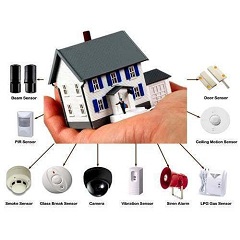A new market research report, from Marketsandmarkets, on the Home Security Systems Market has been divided into sections including, home type, whether the system has been professionally installed or DIY, and whether it is monitored or not, systems type and geographical region. The report includes a global forecast to 2025, which expects to see a growth from USD 53.6 Billion in 2020 to USD 78.9 Billion by 2025, at a CAGR of 8.0% during the forecast period.
The researchers believe that the growth of the home security systems market will be driven by factors such as growing awareness regarding home security systems, the emergence of the Internet of Things (IoT) and wireless technologies and the increasing adoption of IP cameras for video surveillance amid the COVID-19 crisis.
The DIY security systems sector is expected to grow at the highest CAGR during the forecast period, and one of the major factors contributing to this is the cost optimisation ensured by these systems. Some of the products offer integrated alarm triggers and other smart features, which help to detect a break-in by security cameras during regular monitoring activities. Currently, the adoption of home security systems is low, but customers from economically developing countries prefer to deploy DIY systems due to their low cost. Also, some companies help customers with user manuals and guidance tools for system installation and integration. Although the systems do not provide a connection with a professional monitoring station, customers can remotely monitor their homes with the help of smartphones. Thus, with the increasing adoption of home security systems, the DIY systems are expected to be attractive alternatives for new customers with average disposable incomes.
The video surveillance systems segment is expected to hold the largest share of the home security systems market by systems. One of the major benefits of the video surveillance system is that it ensures full-time monitoring in both densely populated areas as well as remote areas. The surveillance cameras today are able to use AI and deep learning to empower security with more reliability and accuracy. For instance, Hikvision launched the Deepinview camera series equipped with deep learning features to provide accurate and consistent video content analytics (VCA) performance. The key benefits of this new technology include human body detection, facial recognition, counting the number of people, and vehicle management, for example. AI-based deep learning and computer vision are able to help predict the possibility of occurrence of a crime before the actual event.
The home security systems market in APAC is witnessing exponential growth. According to Marketsandmarkets, this is mainly because of the growing awareness of potential security threats to individuals and the expanding construction industry. The security-consciousness of buyers is also encouraging project developers to pre-install security solutions in new housing projects. The growing demand for digital and intelligent cameras having CMOS-based image sensors, upgraded image resolution from standard to super-high clarity, the introduction of cameras with built-in face recognition, and video content analysis are some of the key emerging trends in this region








